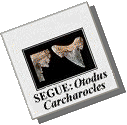|
The oversized teeth of this family hold a particular fascination for many. Those of Otodus are the earliest to reflect this odontological characteristic which culminates in the huge teeth of Carcharocles megalodon (AGASSIZ, 1837) during the Pliocene. As a member of this high profile family, there is rarely unanimous agreement on any group of statements that are assembled. (An excellent example is recent research by Gordon Hubbell presented at the 1999 AES meeting. After studying 95 associated C. megalodon teeth from Central Florida, he has begun to question whether this genus should even be considered a Lamniform.) With this potential for disagreement in mind, I will attempt to be as brief and unopinionated as possible. (For additional information, see Carcharocles genera page.)
This genus (and other family taxa) is known from isolated and/or associated teeth and vertebrae. The teeth are triangular in shape, bear (usually large) triangular and divergent lateral cusplets (occasionally more than one) and can be quite massive (9.7 cm example provided). The dentition is cutting in design with upright anteriors -- the laterals (and posteriors) become more inclined distally. The crown's enameloid is smooth and the lingual face convex (growing stronger as teeth increase
 in size). There is a well-marked basal groove (broader medially), the bulky root has a prominent lingual protuberance and there are one or more scattered foramina. The cutting edge is smooth in teeth identified as Otodus obliquus AGASSIZ, 1843.
in size). There is a well-marked basal groove (broader medially), the bulky root has a prominent lingual protuberance and there are one or more scattered foramina. The cutting edge is smooth in teeth identified as Otodus obliquus AGASSIZ, 1843.
Teeth of this design with irregularly serrate cutting edges had traditionally been ascribed to Otodus subserratus (AGASSIZ, 1843), an identification which is now highly suspect (ref. slide-show) and more likely represents Carcharocles aksuaticus.
The above Otodus dentition-sets were reconstructed by Gordon Hubbell, David Ward and myself. The original associated Eocene material included 92 teeth and 27 centra.
Otodus obliquus is a widespread species, reported from the Danian (Early Paleocene) through Ypresian (Early Eocene) sediments of Africa, Asia, Europe & North America. The weakly serrated (morpho)species, Otodus/Carcharocles. aksuaticus ZHELEZKO, 1999, originally described from western Kazakhstan, has been found in the Woodstock Member of the Nanjemoy Formation of Maryland (USA), Ypres Clay in Belgium and the upper parts of the London Clay in England.
An alternate opinion views these megatoothed sharks as a single taxa, evolving through time. In this scenario, the currently recognized species are deemed morphospecies or chronospecies, wherein temporal snapshots (the fossil record) of various fauna suggest the presence of multiple species. Following this logic, the basal Cenozoic tooth morphology would be represented by Otodus appendiculata (AGASSIZ, 1843) (see: Cretalamna appendiculata) which transitions into O. obliquus during the Late Paleocene, and Carcharocles auriculatus (BLAINVILLE, 1818) in the Middle Ypresian. The chronospecies arguments (unpublished) are very strong and may become more relevant in the future.
Other Site References
Otodus-Carcharocles Segue
Carcharocles genera page.
|